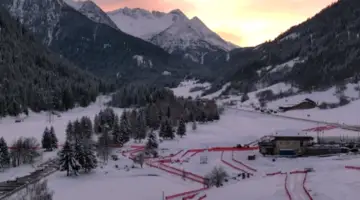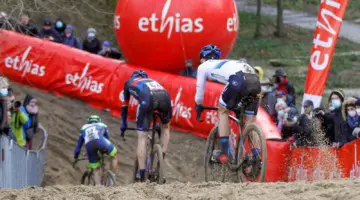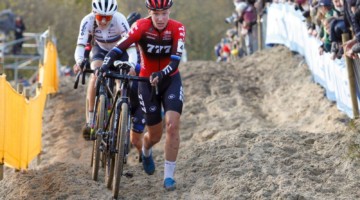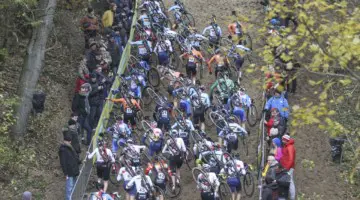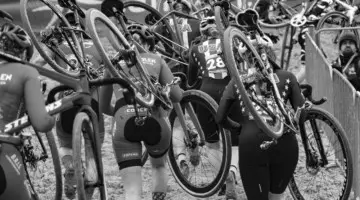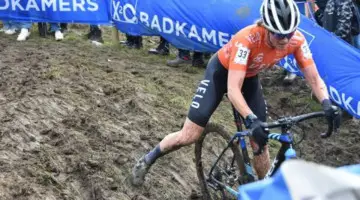It’s been two action-packed weekends of World Cup racing: first Tabor, Czech Republic and then Koksijde, Belgium.
In both cases, I shared the “journey” with fellow Americans chasing dreams this side of the pond.
Americans Abroad
I’m fascinated by the North Americans who choose to do long racing trips to Europe.
The history of racers spending the season in (or moving to) Belgium goes back to first Jonathan Page, then Amy Dombroski and then Elle Anderson. These were all top American competitors who sought to make it to the top-level abroad. Likewise, Katie Compton and Kaitie Keough are currently here to win races.
Plenty of North Americans also come over for Kerstperiode and/or after nationals until the end of the season. Many of those riders come with expectations of making the World Championships team.
Yet, there’s another crew of Americans committed to long stays in Belgium without realistic medal aspirations.
I’ve been staying at the ChainStay cycling house and sharing Cyclocross Custom mechanics with Tyler Cloutier. Rebecca Gross and Max Judalson have also joined Cyclocross Custom for select events. We are over here racing for extended blocks, during the prime time of the American season. What gives?
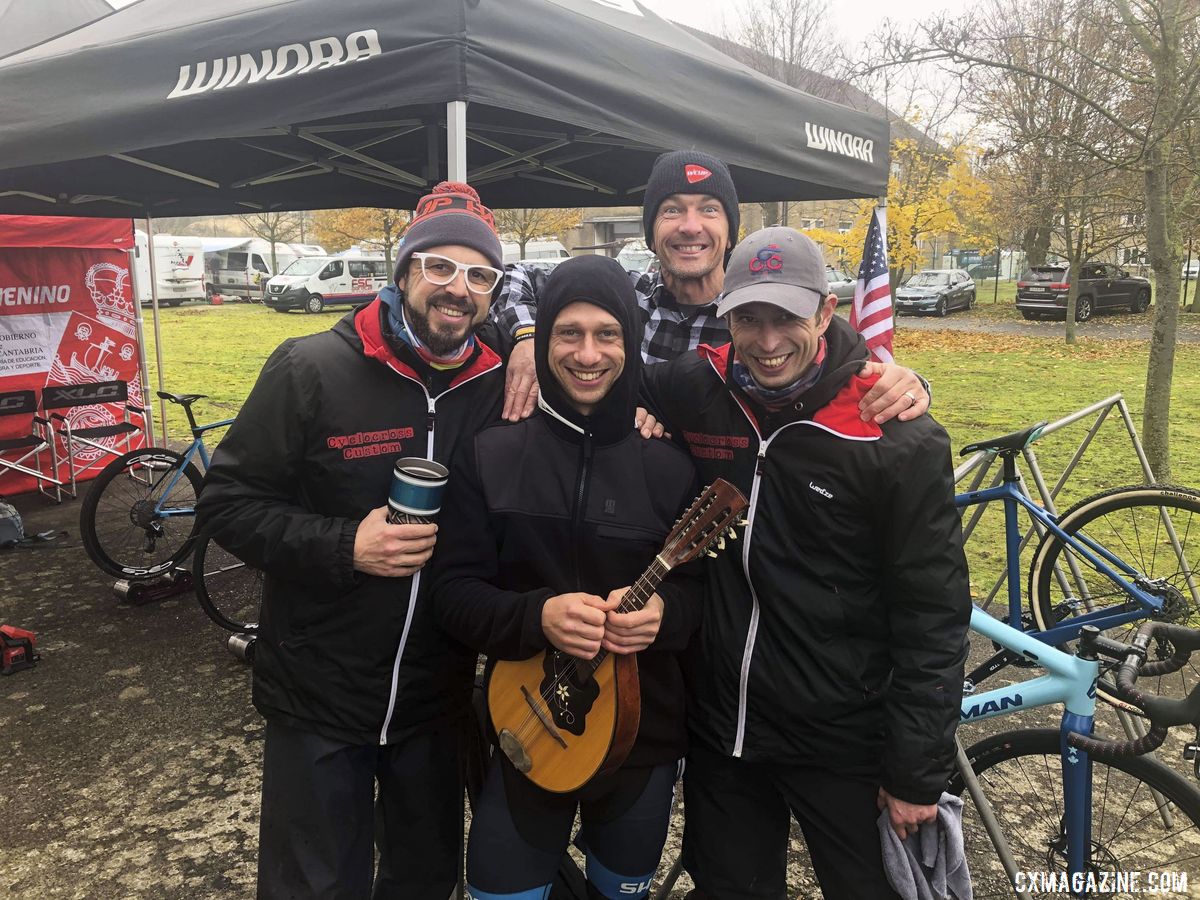
Max Judelson is also working with the Cyclocross Custom folks in Europe.
As I’ve said before, living and racing here is a love it or hate it relationship. Belgium UCI cyclocross, for most Americans, especially the men, means “getting your teeth kicked in,” at least a little bit.
In those circumstances, what keeps a rider coming back for more?
I’m honestly not sure.
Obsession? Being wired a little wrong? Really enjoying getting up after you get knocked down?
When we are together, the topic of money does come up. Note that all of us are on privateer or lower-budget teams, so funds are an ever-present concern. Since we are also riders not making much money racing in the U.S., we are not stepping away from income potential by going abroad.
Likewise, the cost of a trip here is only one plane ticket. (Occasionally, we fly on the continent, but flying in Europe costs considerably less than in North America.) The cost of living can be relatively inexpensive, assuming you don’t rent a car. Max and Rebecca are also largely couch-surfing their stays. All of us also have some means of flexible or remote work.
At times, we talk as if Europe is a cost-savings measure. Yet, can we honestly say that we live in a cold, rainy, sometimes inhospitable country just to save money?
I can’t quite put my finger on why some of us keep on coming back. No doubt, I’m a bit too close to see. I’m sticking to, “This place gets under your skin.”
Are you Racing Hamme?
Are you racing Hamme, the day after Tabor? Um, no.
As it stands now, the World Cup calendar does visit European cities outside of Belgium and the Netherlands. However, the calendar is organized so that no one leaves the Low Countries for long.
In the case of the Bern, Switzerland World Cup, there was a race in Boom, Belgium the day before. With the Tabor, Czech Republic World Cup, there was a race in Hamme the day after.
Bern and Boom are nearly 700 kilometers apart, a tidy 7-hour drive. Tabor and Hamme are about 1,000 kilometers apart, a 10-hour drive.
How do riders do it? Well, I don’t.
Katie Compton and Mark Legg? They settle into the camper and drive through the night. Sanne Cant? Well, she reported that she was at home, in her own bed, by 9:00 p.m.
The trick, it seems, is that many well-funded, well-supported Belgians and Dutch riders catch the last flight out of town. Their support staff? They drive through the night, straight to the next venue.
Our American contingent is a co-ed crew, doing European racing on a shoestring budget. We share a truck and a rental car. The men arrive early to accommodate my race, and I stay late to accommodate theirs. We lack the extra car to whisk us to the airport. We lack the RV to drive in relative comfort. We can hardly ask our mechanics, who work long, hard days for us, to drive through the night. We need them to endure a long season just as we do!
None of us maintain a car in Belgium. Thus, from the airport, we take the train. Indeed, the idea of being back in Belgium and in bed by 9 p.m. gives me a good laugh. Impossible.
And, well, none of us have start contracts for the DVV or SuperPrestige series, anyway!
No, I didn’t go to Hamme. I simply cannot turn it around that fast.
Koksijde – Sandcastles for Thanksgiving
Koksijde took place the Sunday before Thanksgiving. Although, over here, Thanksgiving, like Halloween, seems impossibly far away.
I wish we could say we made sandcastles at the beach. Yet, World Cup racing is a serious proposition even for those of us finishing in the 40s.
Sandcastles, like Thanksgiving, will have to wait for another time.
Just as foreigners have a love or hate relationship with Belgium, we have an even more pronounced love or hate relationship with racing in the sand. When one says that Koksijde is very sandy, she doesn’t mean that there are sand sections here and there. To clarify, Koksijde is racing on sand dunes.
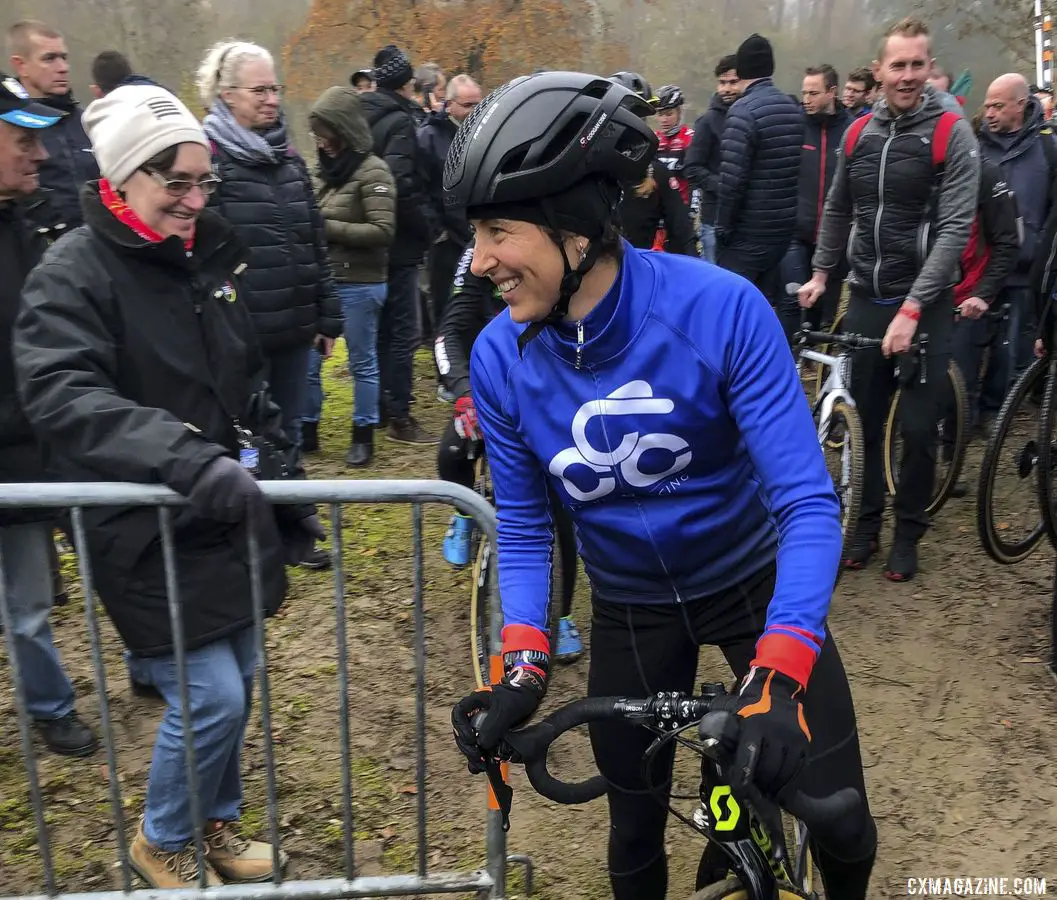
Corey Coogan Cisek gets set for pre-ride at Koksijde.
Let’s stop for a moment and imagine the legal implications of trying to ride your bike on sand dunes in the U.S. If you grew up on the East Coast as I did, you understand sand dunes to be a feature wrapped in fencing. You are not allowed to walk on them, never mind to ride them!
For those not from the sandy Low Countries, sand races are invariably challenging. The Belgian and Dutch riders ride sand from day one of their cyclocross career. They know how to “float” a bike. The disadvantage foreigners experience abroad is all the more pronounced in the sand.
Over years of accumulated experience and hard work, Katie Compton has learned to RIDE the sand. However, for riders like me, Koksijde comes down to, “How well do you run?”
Running is a strength of mine. In fact, Stef Wyman calls me a “Runner,” emphasizing “runner” as if it has a capital “R.”
When someone you admire says something like this to you, it sticks. When I hit a running section on a course, I literally say to myself, “I am a ‘Runner.’”
Koksijde is one part running and one part fluidity. The running part is merely about “dying.” How hard are you able to push yourself? How fast can you keep your feet moving when you feel like you are dying?
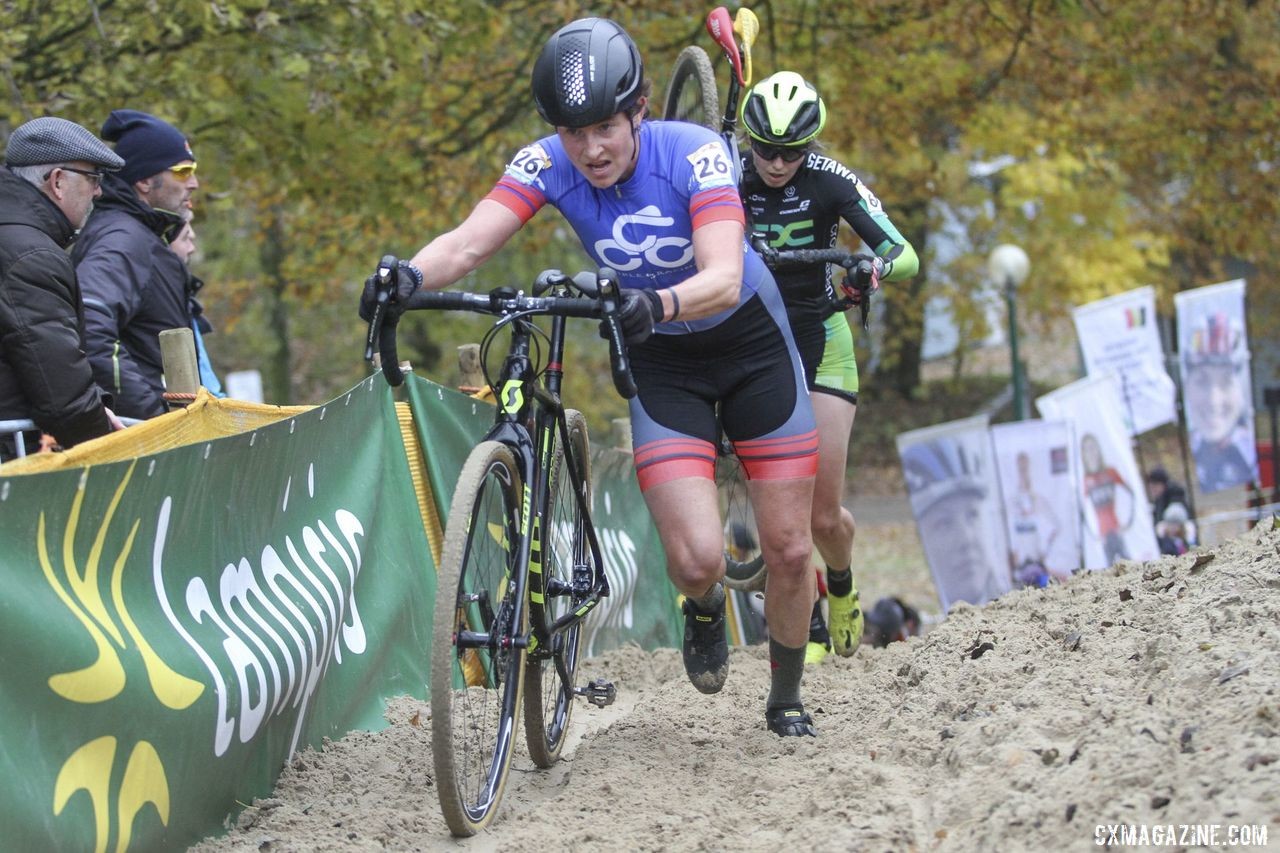
At least in theory, Coogan Cisek is ready for the running at World Cup Koksijde. © B. Hazen / Cyclocross Magazine
Fluidity comes from managing the transitions. We all know the sensation of plowing too far into the sand, digging in and coming off over the handlebars.
Koksijde is all about being honest with yourself and reading your fatigue level. Come off the bike before you are forced off, before your speed falls to zero.
Remounting is an even greater challenge. If you hop onto the bike on flat ground, “full Superman-style,” you drive your bike into sand … and stop.
Accordingly, one needs to be comfortable remounting on a descent. Gravity is your friend. Clipping in right away? Clipping in is purely a “nice to have” entering the sandy drops.
For me, Koksijde was my best-ever World Cup result: 42nd. I was watching the board every lap hoping to climb my way into top-40. Not quite, but I’ll take it!
Which Way do Those Arrows go?
Generally, World Cups are so much easier to negotiate than your “typical” Belgian race. The technical guide is produced in three languages, the venue is usually well signed, etc.
Although Koksijde gets an A+ for having porta potties in riders’ parking (with toilet paper, no less!), their signage score was much, much lower.
I rode with my mechanics to Koksijde. This is generally the easiest way to go. They are familiar with the towns and venues and speak the language fluently. I get to sit back and relax.
Entering Koksijde, I sniffed my first sign of trouble, as there were several reroutes due to construction.
I thought it would be easy. Just go to Aldi and then turn right. After all, that’s what Tyler and I did on our Wednesday pre-ride.
However, organizers closed roads on race day in the interest of traffic management. Add this to roads closed by construction and the fact that Koksijde is a small coastal town hemmed in by the sea, well, and there were problems.
We followed the race signage even though it seemed to lead us in larger and larger circles. Around us, other trucks and campers carrying athletes seemed to be circling. We stopped and asked race staff for directions, but no one knew the way to rider parking. (Of note, everyone we asked knew directions to VIP parking, so it was clear they had been briefed regarding the important stuff.)
As I watched the clock tick forward towards pre-ride time, my mechanics started showing signs of stress and speaking very quickly in Dutch.
In the meantime, I kept it chill and ate a snack. I’ve had some of my very best races in the craziest of circumstances. There are benefits to having been a competitor, in one sport or another, since childhood. I know a little bit of crazy won’t ruffle me!
Eventually, we found some police who had been briefed both as to the location of rider parking and the problem newly-discovered: one or more of the directional signs had been placed exactly backward. Oops.
I did make it to pre-ride, just in time.
Pre-Race Recon
Since Tyler and I had done a thorough pre-ride on Wednesday, race day pre-ride served two purposes: The first was to do a single lap to confirm tire pressure and make sure there were no surprises. (Check: the dunes were still there.) The second was to verify that I knew the way to the start.
A small portion (essentially the start/finish) of the Koksijde course is on a military base. Accordingly, one cannot get on the base until Saturday, so there was no chance to reconnoiter this midweek. Rider parking is on the complete opposite side of the course from the start/finish.
Belgium race custom seems to be, “you should know.” You should know where to park because it’s in the same place every year. You should know best line to the pit, even it’s an unmarked footpath through hedgerows. You should know that you can park at the Aldi to access the course midweek.
Sticking to Belgian custom, you should know your way to the start. Having raced Koksijde last year, I vaguely remembered the way. After taking the time to review, I was able to give directions to the other Americans: “Left out the lot, right before the Lidl (grocery), and then follow your nose.”
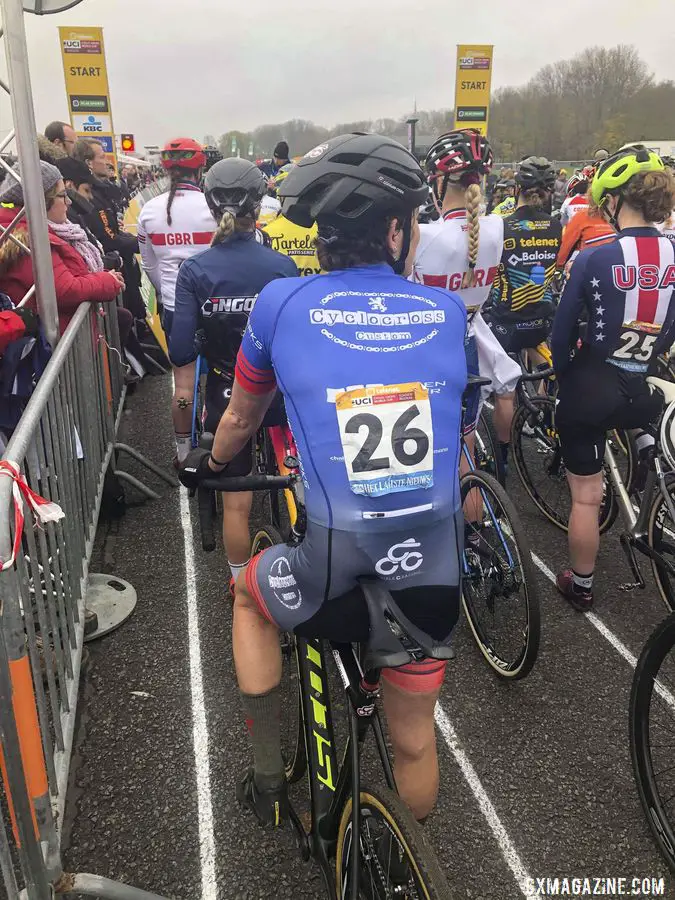
Corey Coogan Cisek did ultimately find her way to the start at World Cup Koksijde.
Literally, there is no signage. You head in the general direction of the start, winding to and fro, crossing the course one time, passing a playground and a campground and then hopping on the last 400 meters of course.
Professional race day preparation in Belgium includes 1) locating a pre-race bathroom, 2) finding the best line to the start and 3) completing warm-up early enough to navigate crowds and ride to said bathroom and start.
USA Cycling Mud Fund
Times they are a-changin’ (finally). For many, many years now, American Junior and U23 men have been coming to Europe to compete, mostly via Geoff Proctor’s Euro Cross Camp. On occasion, Euro Cross Camp, as well as other USA Cycling cyclocross development efforts, brought a couple of young women abroad.
However, historically, there were precious few opportunities for young women to compete in Europe.
The addition of a U23 Women’s World Championships in 2016 and Junior Women’s (U19) category this season, 2020, has changed that.
“If you build it, they will come.”
USA Cycling with Mudfund support just brought 6—count ‘em, six!—U23 and Junior women to Sittard for a racing block. This is new. Outside of Worlds, the U.S. has never brought this quantity of young women ’crossers to Europe at one time.
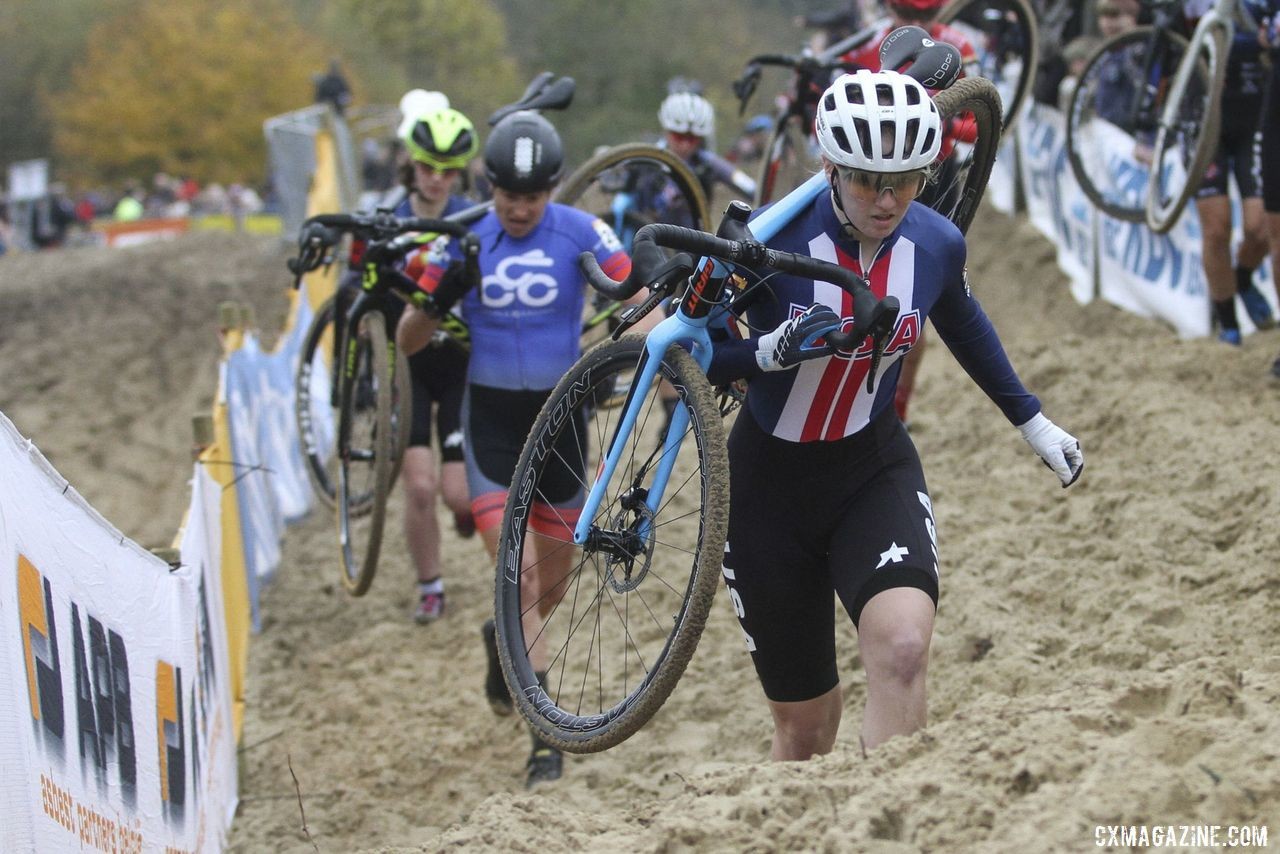
Six young U.S. Junior and U23 women got to race at World Cup Koksijde. © B. Hazen / Cyclocross Magazine
I was delighted to chat a bit with some of these young ladies at Koksijde. They seemed wide-eyed, eager, and over-the-moon to have this opportunity.
They are still in wonderment to be racing with their heroes. As they waited to begin preride, several took selfies with Elite Women.
On one hand, they were legitimately starting a World Cup. On the other hand, they were “fan-girling” their idols. It was a fun juxtaposition to witness.
I’m sure that the trip, and Koksijde in particular, was overwhelming in every way. Despite being a bit “in over their heads,” I’m impressed with the aggression and tenacity with which they rode.
For me, witnessing this “first” for young women’s cyclocross development filled me with a TON of positive energy.
The future is bright.























